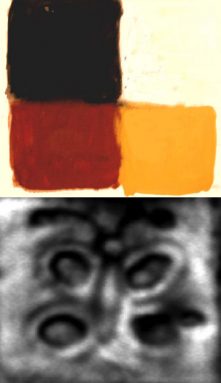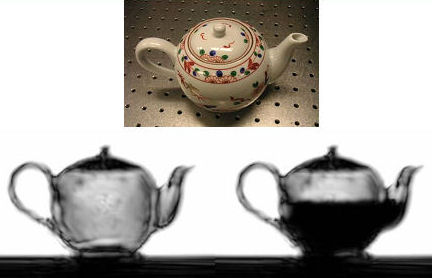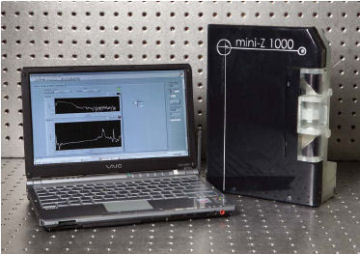Undercover detectives
T-rays are digitally uncovering everything including potential terrorists, buried images on church walls, and subsurface flaws in the foam used to protect space shuttles.
It sounds like the beginning of a mystery movie: Last month, researchers traveled to the French countryside in search of hidden works of art.
But this is no Hollywood blockbuster—at least not yet. It’s a real-life mystery being tackled by a team of engineers, art historians, and computer scientists.
They’ve come to a centuries-old church to look at sections of an old and valuable picture painted onto the church’s stone walls. Local residents uncovered this painted mural in the church of St. Jean the Baptist in Vif, France. It had been hiding beneath layers of painted plaster for hundreds of years.
Everyone wanted to know: How big was the full mural and what did it look like? And they wanted to find out the answer without removing any more of the painted plaster that still covered much of it.
A few years ago, this job would have been impossible. Not any more.
U.S. researchers brought a new type of scanning device with them. It allows them to “see” right through layers of solid materials—including plaster. It relies on a type of electromagnetic energy known as “terahertz radiation.”
This type of radiation may one day take credit for everything from finding terrorists to identifying potentially catastrophic hidden flaws on spacecraft.
 |
|
A centuries-old mural peeks out from behind paint and plaster on the walls of a very old church in France. Researchers recently traveled to France with a T-ray scanning device. It will allow them to view the entire mural, without removing any of the plast
|
| Irl Duling |
Every time you talk on a cell phone, microwave a bag of popcorn, or turn on a lamp to read, you rely on electromagnetic radiation (see sidebar: “Understanding Electromagnetic Radiation”). Elements of this radiation move as waves. Terahertz rays are emissions of energy that have waves from less than a tenth of a millimeter to several millimeters long.
The detective team that went to France carried a device that emits terahertz radiation. Its energy lies between microwaves and infrared radiation, on the low-energy end of the electromagnetic spectrum. Unlike microwaves and X-rays, scientists didn’t know until very recently how to make terahertz radiation, also known as T-rays, explains Daniel Mittleman, an electrical engineer at Rice University in Houston.
“We’ve known for a long time how to generate and detect microwave and infrared radiation,” he says. “But there’s a gap in the middle, and that’s where terahertz is.”
That gap is beginning to disappear now that scientists have begun making T-rays and testing what they can do.
The research team traveling to France, for instance, is using a device about the size of a printer for a home computer. It makes and detects T-rays. Before traveling, the team tested it.
They made paintings with the same kinds of paint pigments that artists would have used hundreds of years ago, and then they covered them up with several layers of plaster, says John Whitaker. He’s a research scientist at the University of Michigan who led the test.
By scanning the fake art with the T-ray device, Whitaker and his colleagues displayed the original paintings behind the plaster—without removing the plaster. The hidden images show up only in black and white at this time. In the future, however, engineers hope to figure out how to distinguish between pigments and then reconstruct the hidden images in color.
 |
|
You’d never guess just by looking at it, but there is a painting of a butterfly underneath the painted square (top image). Scientists covered the butterfly with layers of plaster and squares of paint. Yet when scientists scanned the art with terahertz rad
|
| J. Bianca Jackson |
How did the T-rays recognize the hidden images?
The terahertz device sends a pulse of energy at the covered-over test object, Whitaker says. Materials in the buried painting absorbed some of the T-rays’ energy. Some of the energy was also reflected away.
Different materials reflect or absorb T-rays in different—but predictable—ways, Whitaker says. For example, each of the different pigments behind a layer of plaster will reflect the rays differently. The T-ray device measures how T-rays reflect back from the object. With this data, the researchers can recreate a picture of the hidden items.
The way researchers detect objects with T-rays is analogous to the way we perceive color with visible light, Mittleman explains.
Each color of visible light radiates in waves that have a different frequency—meaning energy waves that repeat a certain number of times per second. What your eye perceives as color is its detection of that energy.
For instance, Mittleman says, “the pigment in your shirt absorbs visible light at a certain frequency. So the light that comes back to you has a certain frequency missing because it was absorbed by the pigments.” Your eye notices that and tells your brain that it has seen a particular color.
The T-ray device does much the same thing. It detects a certain frequency of reflected energy and reads it as a color.
Security, screening, and safety
Just as T-rays can help identify pigments beneath a layer of plaster, they also can identify chemicals—like bombs or illegal drugs—hidden inside suitcases or other items, says Xi-Chen Zhang, a physicist and electrical engineer at Rensselaer Polytechnic Institute in Troy, N.Y.
“If you have a suspicious material, you’d like to know: Is it explosive? Is it a biological or chemical threat? We could use a device to send a T-ray into it,” Zhang says. “By measuring how the ray returns, we can identify certain materials, like explosives or biological materials.”
Zhang is a member of an international organization with the mission to develop a T-ray device to detect explosives. The technology for this particular purpose is now being developed. One of Zhang’s students has invented a portable T-ray generator, which should make such tasks easier.
Called the Mini-Z, it’s about the size of a few stacked laptop computers and only weighs a few pounds. Unlike earlier T-ray generators, this one is very portable. So one could carry it and use it to scan people, equipment, or artwork—without hurting any of them. A company in New York called Zomega Terahertz Corporation manufactures this device for scientists who want to test new uses for T-ray technology.
 |
|
Scanning a china teapot with T-rays will show you whether it’s empty or full. When it’s empty, the rays bounce off the back of the teapot and reflect back to the scanning device, producing an overall light color. Water absorbs T-rays, so rays striking the
|
| Xi-Chen Zhang |
Zhang has used this type of T-ray system to look for defects in the kind of foam that insulates parts of the space shuttle. “The shuttle is covered with thermal insulation to prevent it from being damaged,” Zhang says. “But how can we guarantee it is free of defects? We can send T-rays through it.”
T-rays are ideal for this kind of job because they work where other imaging systems can’t, Mittleman says.
“If there’s an air bubble in the middle of a block of foam, how would you know it was there? You can’t see it,” Mittleman says. “You can’t use X-rays, because foam is mostly air and the X-rays would ignore those holes. That’s why terahertz is perfectly suited. With terahertz, you can detect differences between foam and air.”
Finding bubbles in foam might not sound like a very significant aspect of spaceflight. But researchers now believe defects in foam insulation caused the space shuttle Columbia to overheat and then explode in 2003. All seven astronauts aboard the spacecraft died.
 |
|
Recently, the National Aeronautic and Space Administration, or NASA, has begun scanning the surface of its shuttle spacecraft using a T-ray device produced by a Michigan company called Picometrix.
|
| Rensselaer Polytechnic Institute |
Picometrix also works with drug manufacturers who want to use T-rays to test the quality of the medicines they make. “We are developing ways to weigh tablets to make sure every tablet has exactly the right amount of ingredients,” says Irl Duling. He is the director of terahertz programs at Picometrix.
To measure how much medicine a tablet contains, you target the pill with a pulse of T-rays. “When you hit the tablet, you get a reflection from the front surface and the back surface—it’s two little pulses,” Duling explains. The difference in time that the two pulses take in being reflected back to the T-ray device relates to the amount of matter between the front and back of the tablet. “You can measure the time delay between the two pulses very accurately,” he says, and use that to calculate how much medicine the pill contains.
Picometrix also makes the T-ray scanner that is on its way to France to look at the partially hidden mural. While it’s at the church, researchers will use it to look for any other paintings that might have been similarly plastered over during the past centuries. Re-discovering such murals might help explain why they were covered over in the first place.
“Artworks may have shown something that fell out of favor,” Whitaker says. Throughout European history, new leaders took control in different regions. When a new group moved in, it often had people paint right over art representing the religious views or leaders of an earlier society, he says.
“Uncovering hidden artworks could provide insights into current events at the time a painting was made,” Whitaker says. “We could learn about how the people saw their god or what they thought about medieval saints.”
This project is just the beginning of a new technological approach to art history, Duling says. “In many churches, it’s just a matter of asking: Is there a painting here we don’t know about?” With thousands of churches scattered around Europe, there are plenty of opportunities to search for other hidden treasures.
Understanding Electromagnetic Radiation
Energy travels throughout the universe at the speed of light in the form of electromagnetic radiation. What that radiation is called depends on its energy level.
At the really high-energy end of the spectrum, you’ve got gamma rays. You’re probably familiar with a close cousin to these: X-rays. They’re the ones doctors and dentists use to probe for unusual structures inside your body. Radio waves fall at the extreme other end. Those radio waves are the ones that deliver music and news broadcasts to your home radios.
Ultraviolet rays, visible light, infrared radiation, and microwaves fall at energy levels in between.
Together, all of these types of radiation make up one long, continuous electromagnetic spectrum. Its energy travels in what’s usually referred to as waves.
What separates one type of electromagnetic radiation from another is its wavelength. That’s the length of a wave of that type of radiation. To identify the length of a wave of water in the sea, you would measure the distance from the crest (upper part) of one wave to the crest of another. Or you could measure from one trough (bottom part of a wave) to another.
It’s more difficult to do, but scientists measure electromagnetic waves the same way—from crest to crest or from trough to trough. In fact, each segment of the energy spectrum is defined by this wavelength. Even what we refer to as the heat given off by radiators is a type of radiation—one that has wavelengths in the infrared portion of the spectrum.
Sometimes these segments of the electromagnetic spectrum are also described in terms of frequency. A radiation’s frequency will be the inverse of its wavelength. So the shorter the wavelength, the higher its frequency. That frequency is typically measured in hertz, a unit which stands for cycles per second.—Janet Raloff
Going Deeper:







